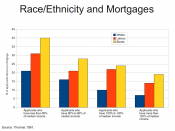Environmental racism refers to the intentional or unintentional location of hazardous waste site and polluting industries in minority communities.The majority of the U.S. population is not aware of the problem of "environmental racism." Most people would not even know what the term means if they heard it. The first time environmental racism gained national attention was in 1982 when a demonstration took place against the building of a hazardous waste landfill in Warren County, NC, which is a predominantly African American.
Why do racial minorities experience more environmental racism than other racial groups? Studies had showed by statistics that many toxic sites are excessively located in predominately minority communities. The numbers of communities of color (Blacks, Hispanics, Asian, etc.) are most affected by hazardous waste sites than to White communities. Medical research also shows that the high rate of illness that people live in the communities are experiencing.
II.Methodology.
I have used a variety of library resources to complete this project. I had search "Academic Search Premier (EBSCO)" and Sociological Abstracts." I am concern with the reason why minorities experience environmental racism more than other racial groups. I think that racial minorities experience environmental racism more than other racial groups because minorities are vulnerable, who won't fight back against environmental racism in fear that it may jeopardize their livings. Minorities are basically minor people in our society, whom nobody notices or care about.
III.Findings.
Toxic Wastes and Race in the US study describes the extent of environmental racism. It revealed:1.Race was the most significant variable associated with the location of hazardous wastes sites.
2.The greatest number of commercial hazardous facilities were located in communities with the highest composition of racial and ethnic minorities.
3. The average minority population in communities with one commercial hazardous waste facility...


